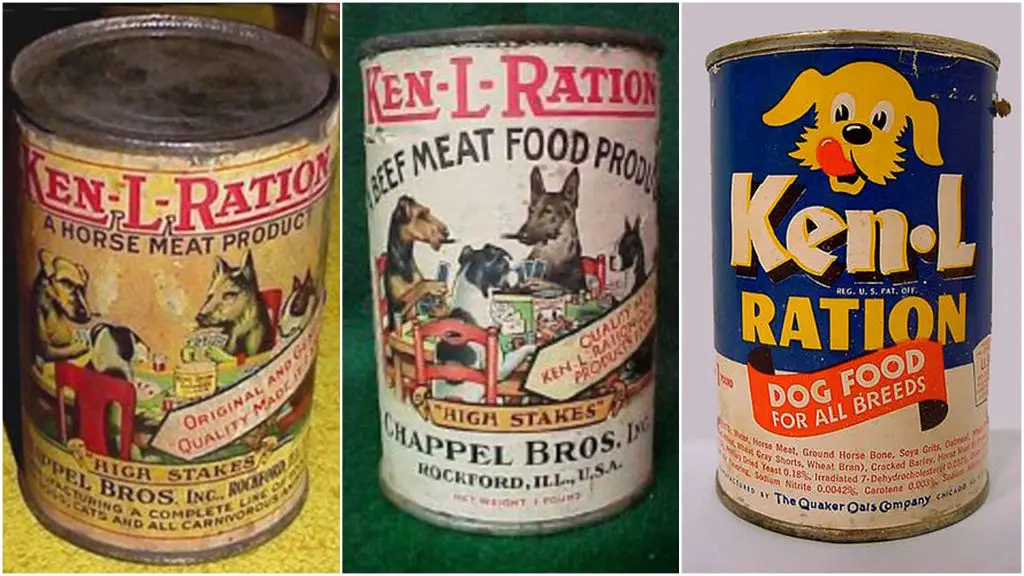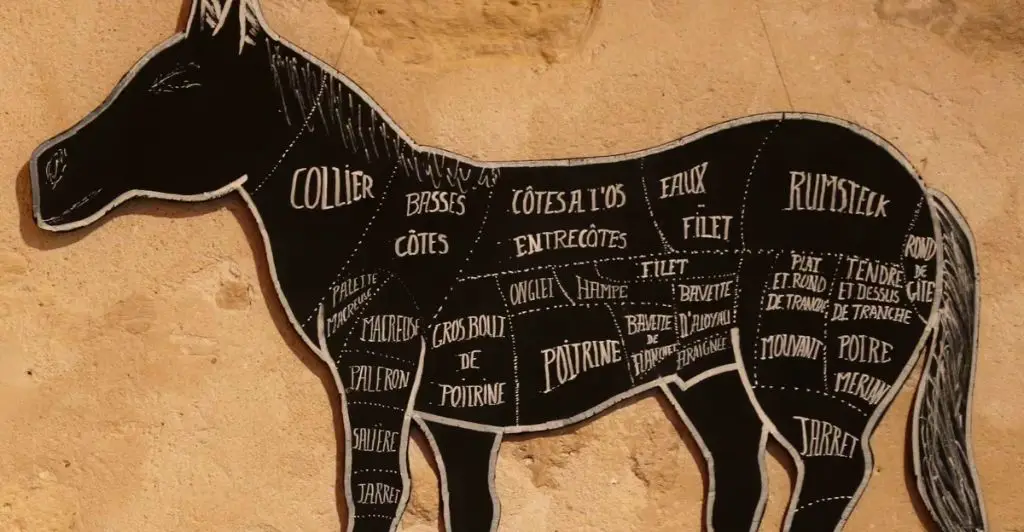Introduction
The history of commercial dog food dates back to around the mid-1800s, when the first canned and dry foods were introduced. In the early days, dog food recipes relied heavily on ingredients that were considered unfit for human consumption or were byproducts of food manufacturing, like organ meats, fish scraps, and grains. While some dog owners continued preparing food at home, the pet food industry expanded greatly over the decades to follow.
One notable but perhaps overlooked ingredient that was commonly used in early commercial dog foods was horse meat. Let’s take a closer look at the use of horse meat in dog food over time.
Horse Meat as Pet Food
The use of horse meat in pet food, particularly dog food, has a long history dating back to the mid-19th century. With the rise of the pet food industry, horse meat became a popular ingredient in many mass-produced dog foods starting in the 1860s and 1870s.
In the United States, the use of horse meat likely began after the Civil War, when large numbers of horses were slaughtered and their meat was readily available. Surplus military horses and worn-out work horses provided a cheap source of animal protein that could be used in early canned and dry dog foods.

By the 1880s, several leading dog food companies like Spratt’s and Ken-L Ration were using horse meat in their formulations. The meat was usually sourced from old horses sent to slaughter once their working lives were over. The pet food industry took advantage of this abundant supply of horse meat to meet the growing commercial demand for canned and kibbled dog foods.
Reasons for Using Horse Meat
In the late 1800s and early 1900s, horse meat became a popular inexpensive protein source for use in dog and cat food. As cities grew more crowded with horses being used for transportation and work purposes, owners often faced difficulties properly caring for older or injured horses. Sending aged horses to slaughterhouses allowed owners to salvage some monetary value in the form of meat. This provided a cheap source of protein that dog and cat food manufacturers could utilize.
Rendered horse meat provided an abundant supply of protein at a lower cost than other meat sources. With minimal regulations at the time, manufacturers found they could substitute cheaper cuts of horse meat in place of beef or pork. As the pet food industry expanded, companies sought inexpensive ingredients like horse meat to maximize profits. Utilizing horse meat, especially lower-quality cuts unfit for human consumption, allowed manufacturers to produce affordable pet food on a large scale.
Popularity and Height of Horse Meat Usage
Horse meat experienced its peak usage as an ingredient in dog food in post-World War II America. In the 1940s and 1950s, horse meat was extremely popular as a protein source in many commercial dog foods. During this time period, approximately 50% or more of all dog food brands contained horse meat as the primary ingredient.

The use of horse meat gradually declined in the following decades, but continued to comprise a significant portion of dog food into the 1970s and 1980s. While exact data is scarce, experts estimate horse meat was an ingredient in 20-40% of dog foods in the 1970s. The peak popularity had passed, but horse meat remained commonly used in the industry.
Public Perception
The public had a largely negative reaction when it was revealed that horse meat was commonly used in dog food in the early 20th century. Many people were appalled to find out horses were being slaughtered for pet food, viewing horses as companion animals rather than livestock. The idea of feeding one’s pet a product made from horse meat was seen as unethical and taboo. There was a sense that it was misleading to consumers who assumed dog food contained only animal byproducts from cattle, pigs and poultry.
The humane treatment of horses also became a concern, with questions raised about the methods used to transport and slaughter horses for pet food. Activists argued that horses suffered unduly through the process. Overall, the prevailing public opinion was that horses held a special status unsuitable for rendering into food for dogs. This revelation damaged the reputation of companies producing dog food with horse meat and fueled demand for reform and transparency.
Decline of Use
The use of horse meat as dog food began declining in the early to mid 20th century for a few key reasons. First, pet food manufacturing became more regulated over time, with stricter ingredients and nutritional requirements set by governments. This made horse meat less appealing and accessible as a protein source.

Second, public perception of horses began to shift. Horses went from being viewed primarily as livestock and work animals to being seen more as companions and pets themselves. With this cultural change, the idea of feeding horse meat to dogs became distasteful to many pet owners.
Finally, the growth of commercial dog food provided an alternative protein source that was more consistent, convenient and did not face the same stigma. Meat meals and by-products offered a cheaper, standardized protein ingredient for manufacturers. All of these factors led to a steady decline in the use of horse meat in dog food from the 1930s onward.
Modern Use of Horse Meat
In today’s world, the use of horse meat in dog food is much less common than it was in the early-to-mid 20th century. However, it is still used in some parts of the world.
One country where horse meat continues to be commonly used in pet food is China. China has a long history of consuming horse meat and views the animal primarily as a food source rather than a pet or work animal. Several Chinese pet food brands use horse meat as their primary ingredient.
Parts of Europe also continue to use horse meat in dog food, albeit on a smaller scale than in previous decades. Italy, France, Belgium and Switzerland are some of the countries where horse meat pet food products are still available. However, even in these regions, other meats like beef, chicken and lamb are now more commonly used.
Outside of these areas, the use of horse meat in commercial dog food today is relatively rare. Public perception shifted in many Western countries, leading to a sharp decline in demand. Most modern pet food companies opt for more commonly accepted red meats.
Alternatives
In modern times, dog food companies have many alternative meat sources to use instead of horse meat. This includes more common and culturally accepted domesticated meat sources like chicken, beef, lamb, turkey, duck and pork. Using these alternative meats avoids the controversy and ethical debates associated with using horse meat.
Chicken is one of the most popular alternatives, as it is relatively inexpensive, lean and nutritious for dogs. Beef and lamb are also nutrient-dense red meat options that provide protein and fat. Turkey and duck offer uniqueness and novelty while delivering complete nutrition.
High-quality dog foods may contain a single protein source or a blend of meats like chicken, lamb and fish. This provides nutritional variety. Some brands use organic or free-range meats as a selling point for discerning pet owners.
Ultimately the most important factor is providing dogs with sufficient protein and fat from digestible animal-based ingredients, rather than the specific type of meat itself. Using alternatives to horse meat allows companies to meet canine nutritional needs without concerns over consumer perception or cultural taboos.
Nutritional Value
Horse meat has a similar nutritional profile to other red meats like beef, pork, and lamb. It is high in protein, providing all the essential amino acids dogs need. Horse meat contains good amounts of iron and vitamin B12, which are important for maintaining a healthy immune system and generating energy in dogs.
Compared to beef, horse meat tends to be leaner with less overall fat content. Studies have found horse meat contains more polyunsaturated fatty acids than saturated fats. The high protein to fat ratio makes horse meat a good option for dogs prone to obesity or pancreatitis.

However, the leanness of horse meat means it may be lower in some fat soluble vitamins like vitamin A and E. Beef tallow or oil is sometimes added to balance out the fat content in dog foods containing horse meat. Ultimately, horse meat offers great protein content for dogs, but the lower overall fat levels distinguish it from meats like beef or lamb.
Conclusion
For a period of time in the late 19th and early 20th centuries, horse meat was commonly used in commercial dog foods, especially in Europe. The meat provided a cheap source of animal protein at a time when many dogs lived outside and worked hard. However, the use of horse meat declined over the decades due to several factors. First, public perception shifted against the practice, especially in countries like the US and UK where horses are seen more as companions. Second, regulations tightened on the production and labeling of pet foods. Third, alternative meats like poultry became more affordable. While small amounts of horse meat are still found in some commercial dog foods today, the practice is relatively rare compared to the peak decades ago. Ultimately, the use of horse meat reflected the times, economics, culture, and values around animal husbandry. As these have evolved, so have pet food formulations. However, the nutritional value of horse meat itself has remained steady over time.